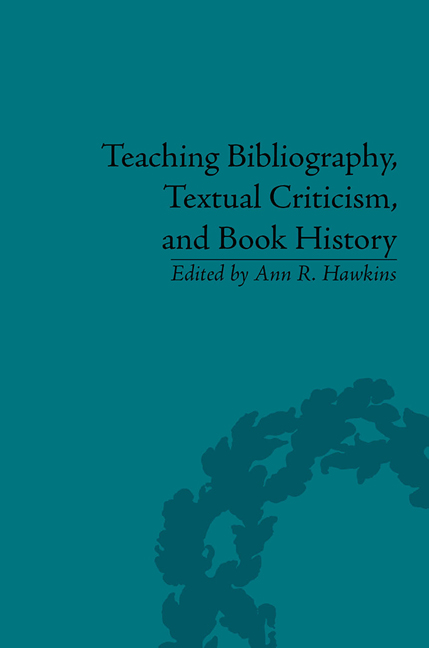Book contents
- Frontmatter
- Contents
- Notes on Contributors
- Foreword
- Introduction: Towards a pedagogy of Bibliography
- Part I Rationales
- Part II Creating and Using Resources
- Part III Methodologies
- Teaching ‘History of the Book’
- Teaching Bibliography and Research Methods
- The Bibliography and Research Course
- Integrating ‘Bibliography’ with ‘Literary Research’: A Comprehensive Approach
- The Hidden Lives of Books
- Learning from Binders: Investigating the Bookbinding Trade in Colonial Philadelphia
- Papermaking, History and Practice
- The Bibliographical Analysis of Antique Laid Paper: A Method
- Teaching Textual Criticism
- Part V Resources
- Index
Papermaking, History and Practice
from Teaching Bibliography and Research Methods
- Frontmatter
- Contents
- Notes on Contributors
- Foreword
- Introduction: Towards a pedagogy of Bibliography
- Part I Rationales
- Part II Creating and Using Resources
- Part III Methodologies
- Teaching ‘History of the Book’
- Teaching Bibliography and Research Methods
- The Bibliography and Research Course
- Integrating ‘Bibliography’ with ‘Literary Research’: A Comprehensive Approach
- The Hidden Lives of Books
- Learning from Binders: Investigating the Bookbinding Trade in Colonial Philadelphia
- Papermaking, History and Practice
- The Bibliographical Analysis of Antique Laid Paper: A Method
- Teaching Textual Criticism
- Part V Resources
- Index
Summary
I teach a fifteen-week, semester-long class on the history and technique of Asian and European papermaking, using a mixture of lectures, hands-on papermaking demonstrations, and assignments. I spend relatively little time on labour /management relations, the economics of paper production, the international paper-market, the relationships between papermakers and publishers, etc., because book specialists need a gut-level appreciation for what went into paper production. Such sensitivities allow a scholar to know, before having specific publishing information, that book A was well made of high-quality materials, while book B was hurriedly executed. This physical ‘read’ on a book can provide valuable insights regarding the producer's motivations, intended audience, etc.
When teaching papermaking in a book history or bibliography course, I focus on advances in the technology of papermaking during the period in question. Depending on course focus and resources, I advise combining readings and discussions on the history and technique of the craft, with a trip to special collections, an actual wet hands-on papermaking session, and ideally, visits to a modern paper mill and a hand papermaking workshop. I'm continually amazed at how important seeing or participating in live papermaking is.
This essay concentrates on a 500-year period in the West: roughly 1300 through to 1800 with brief attention to the earlier invention of the craft in China, its movement east into Korea and Japan, and at about the same time, its movement westward into the Arab Mediterranean area. I also touch on the later invention of the paper machine and events leading up to the manufacture of modern permanent and durable book papers.
Historical Background
- Type
- Chapter
- Information
- Teaching Bibliography, Textual Criticism, and Book History , pp. 142 - 148Publisher: Pickering & ChattoFirst published in: 2014



